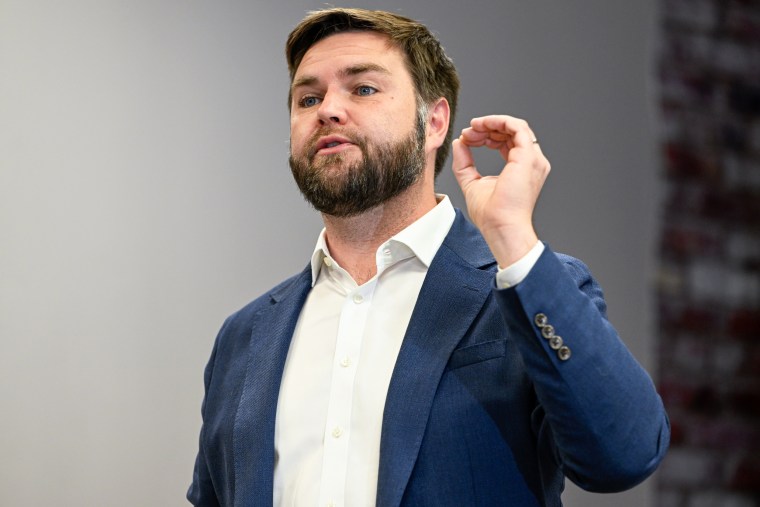WelcomePAC, a Democratic-funded group that aims to reach ticket-splitting voters this fall, has launched a six-figure advertising campaign against Republican J.D. Vance in Ohio’s competitive and increasingly hostile Senate race.
The strategy, shared first with NBC News, targets opposing wings of the GOP: those who dislike Donald Trump, whose endorsement helped Vance win the primary, and those who love Trump but might distrust Vance, who once was an unsparing critic of the former president.
"Why are 1 in 5 Republican voters saying no to J.D. Vance?" the group asks in an ad that will be placed in newspapers serving small rural towns. "There are many reasons."
WelcomePAC’s print, radio and digital ads — pricier TV spots are not part of the plan — represent a small fraction of what others are spending on the contest. But it is a rare outside investment in behalf of Vance’s Democratic opponent, Rep. Tim Ryan, who has kept the race closer than expected with little help from national Democrats who have prioritized other states.

Recent independent polling has shown a toss-up in the battle to succeed Sen. Rob Portman, a relatively moderate Republican. A Spectrum News/Siena College poll this month suggested that 20% of voters who said they planned to vote for Republican Gov. Mike DeWine's re-election also planned to vote for Ryan. But drawing split-ticket conclusions from that figure can be tricky. DeWine registered more crossover support than Ryan did in the survey, with 18% of Democrats favoring DeWine for governor and 7% of Republicans backing Ryan for the Senate.
“Poll after poll shows more than 1 in 5 DeWine voters are rejecting J.D. Vance,” said Irene Lin, a Democratic consultant working with WelcomePAC. “WelcomePAC is launching the ‘Why No J.D.’ campaign to highlight why so many disaffected Republicans and independents are rejecting J.D. Vance and choosing Tim Ryan instead as the guy who will put Ohioans first.”
WelcomePAC, which is heavily funded by LinkedIn co-founder Reid Hoffman, according to Federal Election Commission records, has been active in Ohio, previously organizing media events featuring Republicans who have banded together to campaign against Vance. The group’s ads direct voters to a website, WhyNoJD.com, and seek to paint Vance as a political two-face who is as unpalatable to a Trump voter as he is to a Portman or John Kasich voter. Kasich, Ohio’s former governor, became a prominent anti-Trump Republican after he lost the GOP presidential nomination in 2016.
Luke Schroeder, a spokesperson for the Vance campaign, cast the effort as a waste of money.
"J.D. is proud to have the unified support of Republicans in Ohio, including endorsements from Gov. DeWine and Sen. Portman, and he’s also proud to have the support of hardworking Ohioans from all political backgrounds who are sick and tired of career politicians like Tim Ryan selling them out to the D.C. establishment," Schroeder said. "Ohioans are far smarter than WelcomePAC thinks they are, and they won’t fall for their political trick."
The Vance-Ryan race is closer than many observers had expected given that Trump twice won the state by 8 points. Ryan has tailored his message to appeal to independent and GOP voters, and his campaign has far outraised Vance’s. Combined, a few outside groups have spent a little more than $5 million on the race. But top-spending national Democratic groups have avoided the race, seeing other paths to maintaining and expanding their Senate majority. And Vance, has benefited from more than $25 million in outside money, some of it from groups aligned with Trump and Senate GOP leader Mitch McConnell, according to AdImpact, an ad-tracking firm.
Ryan and his allies have voiced frustration over the lack of spending. At a campaign event last week in the working-class city of Mansfield, halfway between Columbus and Cleveland, Ryan attacked a Democratic strategist’s recent argument to The Washington Post that North Carolina was more worthy of investment because the state has more college graduates.
“That pisses me off,” Ryan told his supporters. “That is an absolute slap in the face to everyone who’s out there busting their a--, who just may not have a college degree. And I will tell you something: I will not let the Democratic Party turn into a party where you have to get a college degree as a passport to get into the party. That’s bulls---. And I’m not gonna let that happen.”
Vance, for his part, has expressed skepticism about the polls showing a close race. He also spends considerable time in his stump speeches wrestling with Ryan’s overtures to GOP voters. At an event last week in the Cleveland suburb of Medina, Vance quickly corrected himself after he called the debate he and Ryan had participated in days earlier a “Republican debate.”
“That was a Freudian slip,” Vance said before he described it as a debate between “the fake Republican, Tim Ryan, and the real Republican, J.D. Vance.”

